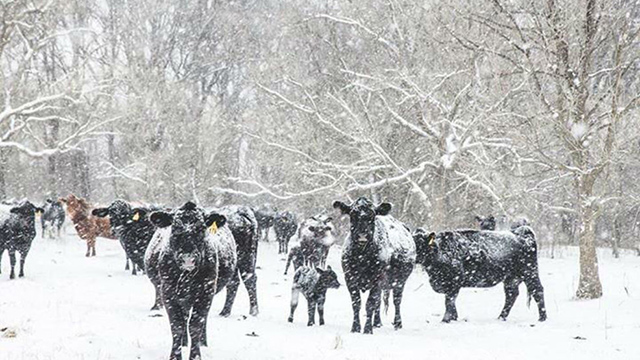Preparing For Your Cattle Herd’s Winter Needs

Not only is there a Christmas and New Year’s countdown, there’s also the countdown to spring calving. It may seem calving season is months away, now is the time to start preparing. Planning ahead is a successful tool for calving season without presenting any surprises.
For spring calving herds, winter months can be the most demanding. During this time, a cow is coming out of her second trimester and moving into the third, and the growing fetus and inclement weather put an increased demand on the cow. At the same time, we need to make sure she’s primed for a successful calving season.
Here are three tips to best prepare for herd’s winter needs:
1. Take Inventory Of Cattle Feed And Labor Resources
Whether we’re using stored or harvested forages, stockpiled grass or winter range, we need to ensure each cow’s nutritional requirements are met. Producers should take inventory of feed resources so that they know both quantity and quality of forage. That way we can plan ahead for winter supplementation needs.
No matter which supplementation option you select, make sure it fits your animal’s nutritional needs and operation’s goals.
2. Determine Cattle Body Condition Score (BCS)
A key factor that will play into your feeding strategy is the Body Condition Score of your cow herd. Nutrition strategies will vary if you are working to maintain a BCS score or if you need to add weight to build up to those scores.
If producers are looking to maintain BCS (assuming cows are at a BCS of 6), the diet and supplementation should match nutrients needed for maintenance. If producers need to improve BCS, the diet’s nutrients (primarily energy and protein) will need to increase to meet requirements for gain. Those nutrient levels will depend on the amount of gain or BCS improvement needed, length of time to achieve an improvement in BCS and environment (temperature).
Ideally, BCS would be assessed prior to winter, but it can be done as we enter winter and the third trimester. There’s still time to change BCS prior to calving, maintaining a consistent BCS year-round is the recommended strategy.
3. Take A Look At Animal Health Protocols
Work with a veterinarian to make sure that your animal health protocols are in place and up-to-date going into the winter months. It’s especially important as we go into calving to make sure everything from vaccinations and deworming to calf health protocols are in place and ready to go. Come spring calving, you’ll be confident in the steps you’ve taken to prepare both the cow and her newborn calf for success.
If producers don’t prepare for winter herd needs, they could see a situation where cows go backwards in BCS, creating potential rebreeding challenges. Evaluating your feed and labor resources, maintaining an acceptable BCS, and making sure your animal health protocols are up to par can help your herd thrive through the winter and into spring.
Situations occur where forages or rations fall short of the nutrients your cows’ need.
Below is a link to a BCS Chart. Body condition scoring can tell you quite a bit about your herd, and the results can be used to make important management decisions.